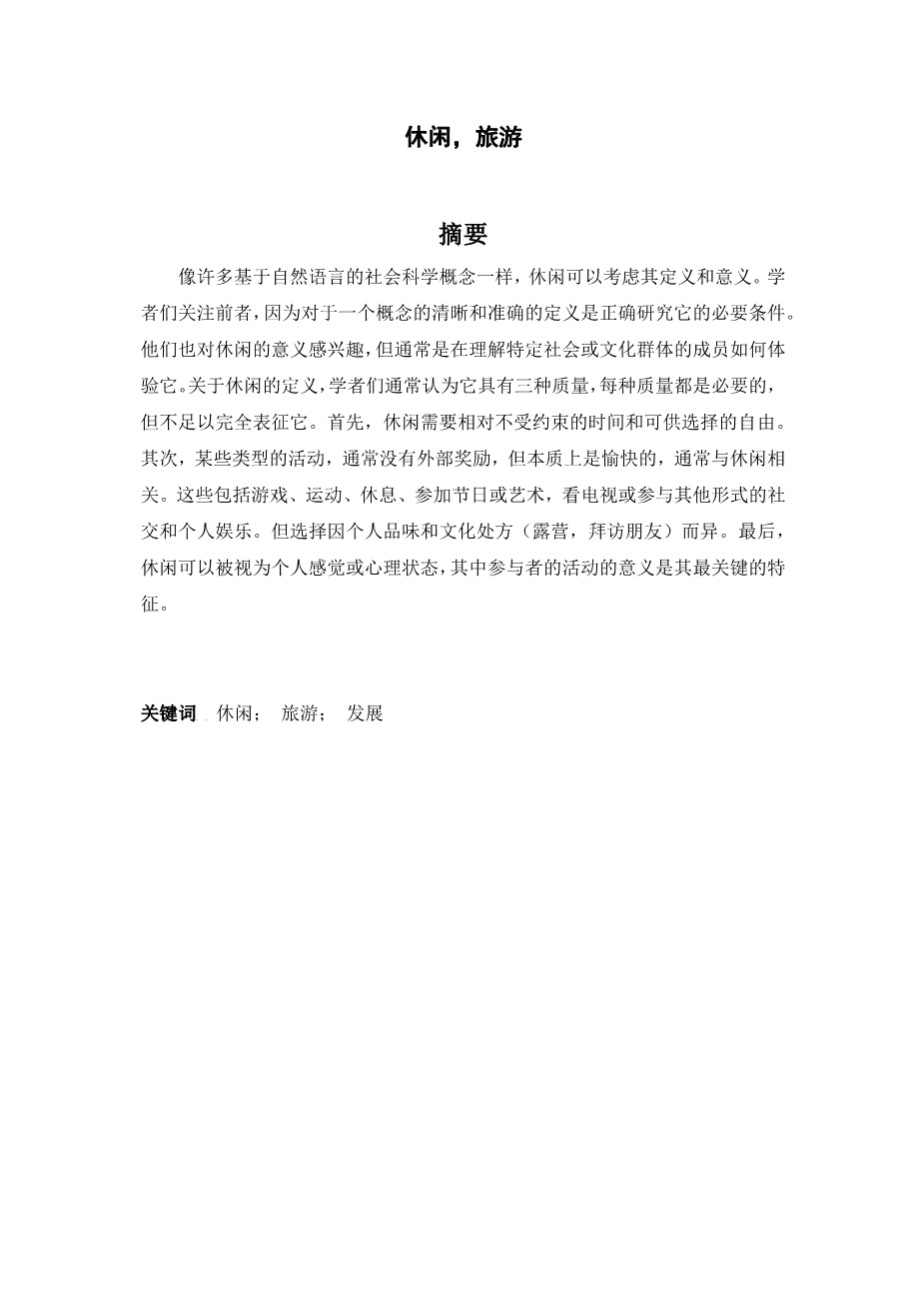Garry Chick
The Pennsylvania State University, Pennsylvania, USA
Department of Recreation, Park, and Tourism Management, Pennsylvania, USA
Like many social science concepts based on terms from natural languages, leisure can be con- sidered with regard to its definition and its mean- ing. Scholars are concerned with the former, inasmuch as a clear and precise definition of a concept is necessary for proper study of it. They are also interested in the meaning of leisure but usually in terms of understanding how members of particular social or cultural groups experience it.
With respect to the definition of leisure, scholars commonly regard it as having three qual- ities, each necessary but none sufficient to fully characterize it. First, leisure requires time that is relatively unobligated and where freedom of choice is available. Second, certain kinds of activities, usually without external reward but intrinsically pleasurable, are commonly associ- ated with leisure. These include play, games, sport, resting, participating in festivals or the arts, watching television, or engaging in other forms of social and individual entertainment. But choices vary with both individual tastes and cultural prescriptions (camping, visiting friends)
and proscriptions (pornography, gambling). Finally, leisure may be regarded as a personal feeling or condition of mind where the meaning attributed to the activity by a participant is its most critical feature.
Free time
Tourists typically take time off from their normal routines in order to ▶ travel. While the amount of time that individuals can devote to leisure,
including tourism, does vary, recent research sug- gests that average free time availability may not differ greatly both individually and cross- culturally. Rubin et al. (1986) found that adults in four Amazonian tribes spend approximately the same amount of time in both work and leisure. This was the case despite the fact that two of them lived in substantially degraded environments while the situations of the other two afforded relative plenty. Rather than spending more time working, members of the two tribes living in the degraded environments chose to use fewer calo- ries by spending more time in passive leisure, while members of the other two spent relatively more time in active leisure. Chick and Shen (2011) compared time spent in leisure across 12 traditional groups located in South America,
▶ Africa, and Oceania. They found that while these groups differed widely in variables such as
subsistence method and population density, they
# Springer International Publishing Switzerland 2015
J. Jafari, H. Xiao (eds.), Encyclopedia of Tourism, DOI 10.1007/978-3-319-01669-6_317-1
2 Leisure, tourism
spend very similar amounts of time in productive and nonproductive activities.
Whether free time is increasing, decreasing, or staying the same in modern societies has been disputed. The post-2008 economic downturn resulted in enforced free time for many, while corporations and governments, particularly in
▶ Europe, have sought to reduce guaranteed
▶ vacation time for workers. In May 2011, for example, German Chancellor Angela Merkel
asserted that countries heavily in debt, such as
▶ Greece, ▶ Spain, and ▶ Portugal, should sub- stantially reduce government-mandated vacation time and raise the minimum age for retirement.
The Center for Economic and Policy Research in Washington DC indicates that the ▶ United States is the only country with an advanced econ-
omy that fails to mandate a minimum paid vaca- tion time or ▶ holiday to all employees. In contrast, ▶ Austria and ▶ Portugal guarantee workers with a minimum 22 paid ▶ vacation days and 13 annual paid holidays. ▶ Japan, the least generous next to the ▶ United States, guar- antees 10 paid vacation days and 15 national hol-
idays per year. Changes in mandated vacation time and retirement age have obvious social and economic implications for tourism, including tourists and tourism providers.
Leisure as an activity and state of mind
Anthropologists have claimed that leisure activi- ties, such as art, dance, music, games, play, toys, sport, and socializing are common to all humans.
▶ Travel for pleasure and tourism has not typi- cally been included as a human universal, but
visiting others has been common in history. Travel required in order to seek mates outside of one’s own social group is typical. Hadza hunter-
gatherers of northern ▶ Tanzania, for example, usually live in groups of about 25. While mar-
riage sometimes occurs between individuals liv- ing in larger camps, people frequently travel to other camps to visit, socialize, and learn about marriage possibilities.
The most famous anthropological example of expressive travel is the ceremonial Kula ring
wherein shell necklaces were traded in a clock- wise fashion around the islands of the Milne Bay Province of present-day ▶ Papua New Guinea, described by Bronislaw Malinowski in 1922.
While shell armbands circled in a counterclock- wise direction, Kula exchange often required par- ticipants to navigate hundreds of miles of open water for visits to their trading partners. Simi- larly, the potlatch was a form of ritual exchange among members of indigenous tribes of the northwest coast of North America that involved visitation between communities. Therefore, travel for utilitarian and ceremonial activities as well as leisure may have been common in human history.
For many, both time and activity are irrelevant a
剩余内容已隐藏,支付完成后下载完整资料


英语译文共 5 页,剩余内容已隐藏,支付完成后下载完整资料
资料编号:[445353],资料为PDF文档或Word文档,PDF文档可免费转换为Word
以上是毕业论文外文翻译,课题毕业论文、任务书、文献综述、开题报告、程序设计、图纸设计等资料可联系客服协助查找。
您可能感兴趣的文章
- COVID-19时期的旅游业和可持续发展:以西班牙为例外文翻译资料
- 农民相对剥夺感对乡村旅游可持续发展的影响机制外文翻译资料
- 校园大学生的旅行行为——以亚洲某乡村大学为例外文翻译资料
- 内容旅游与地方社区响应:鹫宫的“幸运之星”和“协作动漫旅游”外文翻译资料
- 基于符号互动理论的遗产旅游资源开发与重塑——以良渚古城遗址为例外文翻译资料
- 在TikTok上映射互联网名人:探索注意力、经济和可见性劳动力外文翻译资料
- 基于社区游客视角的环境责任行为的概念和度量外文翻译资料
- 温泉小镇的再造:维希的独特案例——副标题外文翻译资料
- 基于IP理念的桐乡丰子恺文化旅游开发研究外文翻译资料
- 特殊事件对旅游业的影响及其应对措施研究——新冠肺炎疫情对全球旅游业的影响及其应对措施外文翻译资料


